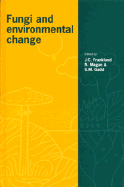Book contents
- Frontmatter
- Contents
- List of contributors
- Preface
- 1 Effects of climate change on fungal diseases of trees
- 2 Effects of climate change on Fusarium foot rot of winter wheat in the United Kingdom
- 3 Effects of UV-B radiation (280–320 nm) on foliar saprotrophs and pathogens
- 4 Implications of global warming and rising sea-levels for macrofungi in UK dune systems
- 5 Red Data Lists and decline in fruiting of macromycetes in relation to pollution and loss of habitat
- 6 Effects of dry-deposited SO2 and sulphite on saprotrophic fungi and decomposition of tree leaf litter
- 7 Effects of atmospheric pollutants on phyllosphere and endophytic fungi
- 8 Influences of acid mist and ozone on the fluorescein diacetate activity of leaf litter
- 9 Mycorrhizas and environmental stress
- 10 Myccorhizas, succession, and the rehabilitation of deforested lands in the humid tropics
- 11 Potential effects on the soil mycoflora of changes in the UK agricultural policy for upland grasslands
- 12 Uptake and immobilization of caesium in UK grassland and forest soils by fungi, following the Chernobyl accident
- 13 Effects of pollutants on aquatic hyphomycetes colonizing leaf material in freshwaters
- 14 Fungi and salt stress
- 15 Fungal sequestration, mobilization and transformation of metals and metalloids
- 16 Urban, industrial and agricultural effects on lichens
- 17 Fungal interactions with metals and radionuclides for environmental bioremediation
- 18 Impact of genetically-modified microorganisms on the terrestrial microbiota including fungi
- 19 Has chaos theory a place in environmental mycology?
- Index of generic and specific names
- Subject index
Preface
Published online by Cambridge University Press: 05 November 2011
- Frontmatter
- Contents
- List of contributors
- Preface
- 1 Effects of climate change on fungal diseases of trees
- 2 Effects of climate change on Fusarium foot rot of winter wheat in the United Kingdom
- 3 Effects of UV-B radiation (280–320 nm) on foliar saprotrophs and pathogens
- 4 Implications of global warming and rising sea-levels for macrofungi in UK dune systems
- 5 Red Data Lists and decline in fruiting of macromycetes in relation to pollution and loss of habitat
- 6 Effects of dry-deposited SO2 and sulphite on saprotrophic fungi and decomposition of tree leaf litter
- 7 Effects of atmospheric pollutants on phyllosphere and endophytic fungi
- 8 Influences of acid mist and ozone on the fluorescein diacetate activity of leaf litter
- 9 Mycorrhizas and environmental stress
- 10 Myccorhizas, succession, and the rehabilitation of deforested lands in the humid tropics
- 11 Potential effects on the soil mycoflora of changes in the UK agricultural policy for upland grasslands
- 12 Uptake and immobilization of caesium in UK grassland and forest soils by fungi, following the Chernobyl accident
- 13 Effects of pollutants on aquatic hyphomycetes colonizing leaf material in freshwaters
- 14 Fungi and salt stress
- 15 Fungal sequestration, mobilization and transformation of metals and metalloids
- 16 Urban, industrial and agricultural effects on lichens
- 17 Fungal interactions with metals and radionuclides for environmental bioremediation
- 18 Impact of genetically-modified microorganisms on the terrestrial microbiota including fungi
- 19 Has chaos theory a place in environmental mycology?
- Index of generic and specific names
- Subject index
Summary
The ‘Environment’ is now on political agendas, and it is time the mycological voice was heard in the upsurge of national and international debates that have followed in the wake of the 1992 Earth Summit at Rio de Janeiro. Despite worldwide concern over environmental changes, fungi vital to the functioning of ecosystems are rarely mentioned.
This is the first symposium volume to focus on fungi in relation to man-made changes in the natural environment. It comprises papers presented at a British Mycological Society Symposium held at Cranfield University, UK, in 1994. The authors, all actively engaged in mycological research, cover widely diverse but highly topical subjects such as global warming, rising sea levels and destruction of rainforests. Speculation is bound to be found, but experimental evidence has been included wherever possible. Selection will also be apparent. The number of mycologists in this field is not great and many environmental problems remain untouched. Our aim is to stimulate thought on some of the issues of the day, and to point to the need for more research at every level, from field recording to cell physiology.
In Chapter 1 Lonsdale and Gibbs discuss predicted changes in global climate in relation to associations between fungal pathogens and perennial, woody hosts, and the extent to which the geographic range and pathogenic activity of the fungus (they do not always coincide) might alter.
- Type
- Chapter
- Information
- Fungi and Environmental Change , pp. xiii - xviPublisher: Cambridge University PressPrint publication year: 1996

